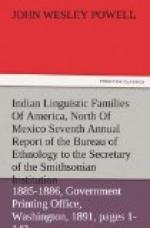= Chetimachas, Gallatin in Trans. and Coll. Am. Antiq. Soc., II, 306, 1836. Gallatin in Trans. Am. Eth. Soc., II, pt. 1, xcix, 1848. Latham, Nat. Hist. Man, 341, 1850. Gallatin in Schoolcraft, Ind. Tribes, III, 402, 1853.
= Chetimacha, Latham in Proc. Philolog.
Soc. Lond., II, 31-50, 1846.
Latham, Opuscula, 293, 1860.
= Chetemachas, Gallatin in Trans.
Am. Eth. Soc., II, pt. 1, 77, 1848
(same as Chitimachas).
= Shetimasha, Gatschet, Creek Mig.
Legend, I, 44, 1884. Gatschet in
Science, 414, April 29, 1887.
Derivation: From Choctaw words tchuti, “cooking vessels,” masha, “they possess,” (Gatschet).
This family was based upon the language of the tribe of the same name, “formerly living in the vicinity of Lake Barataria, and still existing (1836) in lower Louisiana.”
Du Pratz asserted that the Taensa and Chitimacha were kindred tribes of the Na’htchi. A vocabulary of the Shetimasha, however, revealed to Gallatin no traces of such affinity. He considered both to represent distinct families, a conclusion subsequent investigations have sustained.
In 1881 Mr. Gatschet visited the remnants of this tribe in Louisiana. He found about fifty individuals, a portion of whom lived on Grand River, but the larger part in Charenton, St. Mary’s Parish. The tribal organization was abandoned in 1879 on the death of their chief.
CHUMASHAN FAMILY.
> Santa Barbara, Latham in Trans. Philolog. Soc., Lond., 85, 1856 (includes Santa Barbara, Santa Inez, San Luis Obispo languages). Buschmann, Spuren der aztek. Sprache, 531, 535, 538, 602, 1859. Latham, Opuscula, 351, 1860. Powell in Cont. N.A. Eth., III, 550, 567, 1877 (Kasua, Santa Inez, Id. of Santa Cruz, Santa Barbara). Gatschet in U.S. Geog. Surv. W. 100th M., VII, 419, 1879 (cites La Purisima, Santa Inez, Santa Barbara, Kasua, Mugu, Santa Cruz Id.).
X Santa Barbara, Gatschet in Mag.
Am. Hist., 156, 1877 (Santa Inez,
Santa Barbara, Santa Cruz Id., San Luis
Obispo, San Antonio).
Derivation: From Chumash, the name of the Santa Rosa Islanders.
The several dialects of this family have long been known under the group or family name, “Santa Barbara,” which seems first to have been used in a comprehensive sense by Latham in 1856, who included under it three languages, viz: Santa Barbara, Santa Inez, and San Luis Obispo. The term has no special pertinence as a family designation, except from the fact that the Santa Barbara Mission, around which one of the dialects of the family was spoken, is perhaps more widely known than any of the others. Nevertheless, as it is the family name first applied to the group and has, moreover, passed into current use its claim to recognition would not be questioned were it not a compound name. Under the rule adopted the latter fact necessitates its rejection. As a suitable substitute the term Chumashan is here adopted. Chumash is the name of the Santa Rosa Islanders, who spoke a dialect of this stock, and is a term widely known among the Indians of this family.




